
Each year, we conduct an extensive review of Bitcoin and crypto wallets available in Australia. To arrive at these picks, we've compared more than 50 wallets on features like security, usability, cost and supported coins. This list is then reviewed each month to make sure it is accurate and up to date.
The picks below are designed to help you choose the best wallet for your goals and holdings. Since some wallets are better at some things than others, it's common to use multiple wallets at once. For instance, you might use one wallet for staking and another for its Web3 features.
Regardless of what you choose, it's a good idea to pair any software wallet with a hardware wallet for added security.
Best crypto wallets in Australia for 2025
- Ledger Nano S Plus – Best wallet overall
- Ledger Flex – Best wallet for staking
- Ledger Nano X – Best hardware wallet and best for XRP
- Trezor One – Best value and beginner crypto wallet
- Base App (Coinbase Wallet) – Best exchange wallet
- Trezor Model T – Best wallet for experienced users
- Zengo - Best for private transactions
- Ledger Stax – Best-designed crypto wallet
- Phantom – Best Solana wallet
- MetaMask – Best software wallet
- COLDCARD Mk4 – Best Bitcoin wallet
- Atomic – Most loved by customers
- Kraken – Best open source wallet
- eToro – Best for copy traders
This is not an endorsement of cryptocurrency or any specific provider, service or offering. It is not a recommendation to trade or use any services.
Ledger Nano S Plus – Best wallet overall
Ledger Nano S Plus Wallet
Finder score
Price (USD)
Assets
Wallet type
The Nano S Plus is our pick for the best crypto wallet overall thanks to Ledger's robust security, wide range of cryptocurrencies and NFTs all at the affordable price point of US$79.
The Nano S Plus is a hardware wallet manufactured by French company Ledger, which has been around since 2014. Ledger wallets have a clean security track record, with no hardware breaches recorded.
The accompanying Ledger Live app also allows you to swap cryptocurrencies, purchase them with debit or credit card or put them to work via DeFi and staking. Ledger Live features the Merlin dashboard which lets you interact with 1,000+ DeFi protocols across 10 chains and track yield, PnL and impermanent loss.
You'll be hard-pressed to find another wallet that offers so much value at such a moderate price.
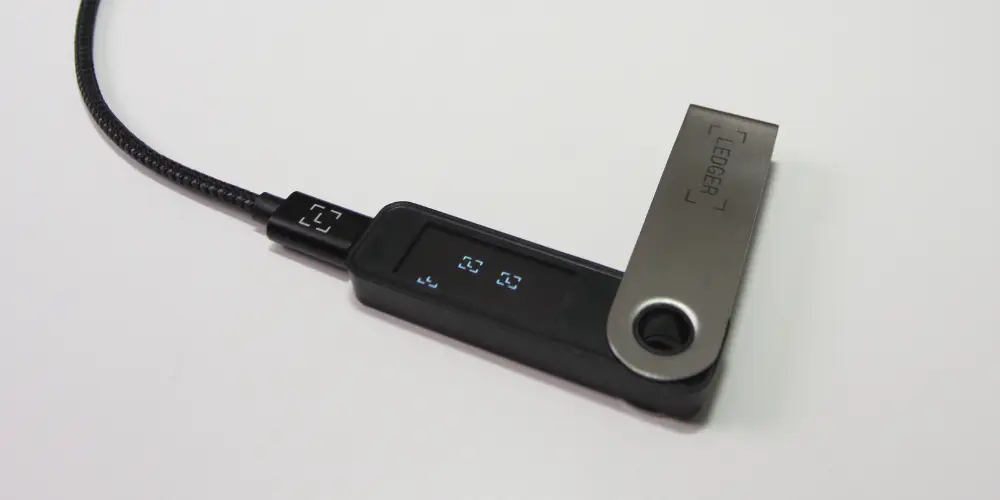
- Cheaper than the Nano X, but has most of the same features
- Supports 5,500 tokens
- Highly secure
- CC EAL 6+ rating
- Stores private keys to NFTs
- Not Bluetooth enabled
- Not iOS compatible
Ledger Flex – Best wallet for staking
Ledger Flex Wallet
Finder score
Price (USD)
Assets
Wallet type
We've named the Ledger Flex as the best staking wallet because of its range of supported blockchains, coins and staking options, as well as its compatibility with iOS.
Like all Ledger wallets, the Flex supports over 50 third-party wallets and 5,000+ coins, as well as native staking for coins like Ethereum (ETH) and Polkadot (DOT) using the Ledger Live software.
You can easily stake over 25 cryptocurrencies through third-party integrations, including crowd favourites like Avalanche (AVAX) or Solana (SOL) as well as 1,000+ DeFi protocols.
Its next-gen E Ink touchscreen also gives it an edge over the more-affordable Ledger models, the Nano S Plus and Nano X, but without the price tag of the top-of-the-line Ledger Stax.
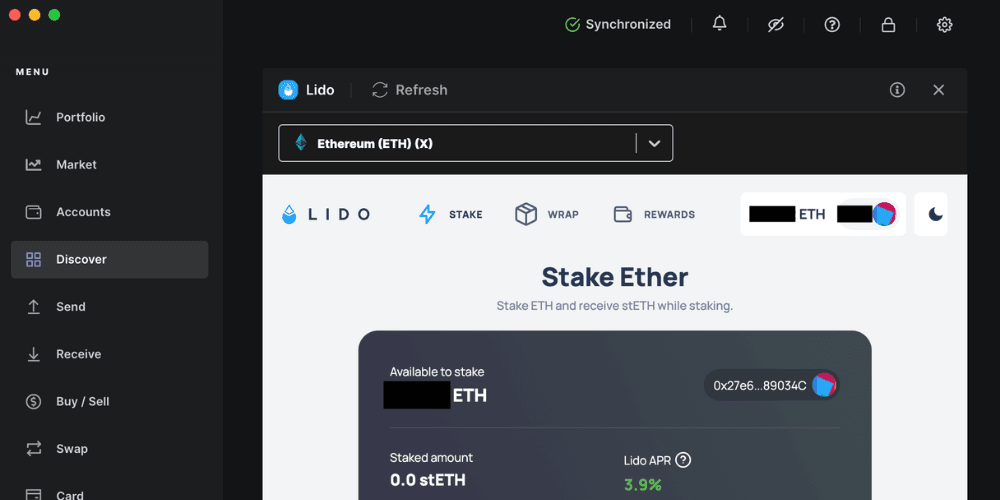
- You can stake without sacrificing your security
- Ledger has great native and third-party staking support
- Only some cryptos can be staked via Ledger Live
Ledger Nano X – Best hardware wallet (and best for XRP)
Ledger Nano X Wallet
Finder score
Price (USD)
Assets
Wallet type
The Ledger Nano X is one of the best-known and feature-rich hardware wallets on the market. Its robust security, support for a wide range of cryptos and connection to both desktop and mobile interfaces are some of the reasons it was our pick for the best hardware wallet.
The Nano X hardware is supported by the Ledger Live app, which helps you manage up to 5,500 cryptos, Ethereum and Polygon NFTs and over 1,000 DeFi apps from a single user interface available on both desktop and mobile. It's also a great choice for storing XRP, which is also supported on Ledger Live.
You can also stake a selection of your digital assets via Ledger Live or put them to work in DeFi.
Ledger has a long track record of providing industry-standard level security for digital assets.
The Nano X is Bluetooth-enabled and compatible with both Android and IOS mobile devices, so you can manage your crypto on the go.
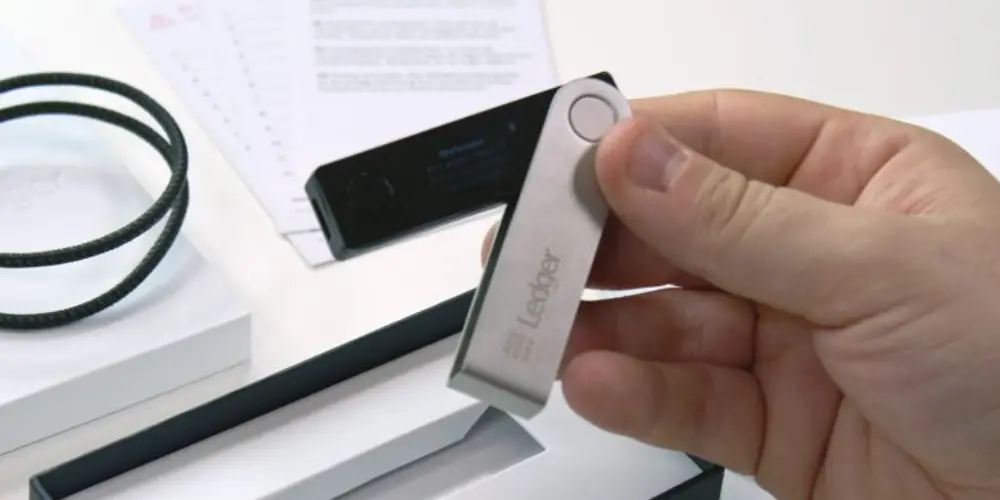
- Manage over 5,500 crypto assets
- Highly secure
- CC EAL 5+ rating
- Mobile and desktop compatibility
- Stores private keys to NFTs
- Expensive compared to the Nano S Plus
Trezor Model One – Best value and beginner hardware wallet
Trezor Model One Wallet
Finder score
Price (USD)
Assets
Wallet type
The Trezor Model One is the original cryptocurrency hardware wallet and extremely good value at US$49, making it a great choice for beginners looking to get their first hardware wallet. It's a small USB device for securely storing the private keys to your digital assets in cold storage – offline and physically separated from your computer.
The Model One is all you need to manage major crypto assets like Bitcoin (BTC) and Ether (ETH). It is excellent for using with DeFi applications on Ethereum and layer-2 networks.
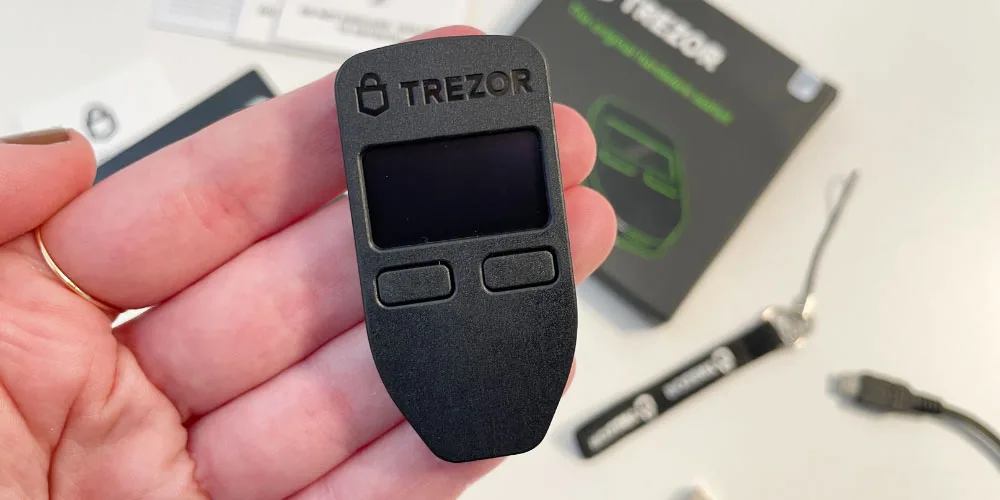
- Arguably the most affordable hardware wallet
- Easy-to-use interface and software
- Can be linked with MetaMask for use with Web3 and DeFi
- Highly reputable and rated brand
- No Solana support
- Not Bluetooth enabled
- Not iOS compatible
Base App (Coinbase Wallet)– Best exchange wallet
Base App
Price (USD)
Assets
Desktop
Web browser
Wallet type
Coinbase's wallet - recently rebranded to Base App - doesn't require a Coinbase account to use it but verified account holders can connect directly to Coinbase's exchange to buy crypto. This seamless integration makes it our pick for the best exchange wallet.
The Base App can be downloaded as a mobile app or browser extension and features an easy-to-navigate UI consistent with the Coinbase exchange. The wallet is automatically configured to support many blockchains, including all EVM-compatible chains, Solana and more.
Security on the Base App is consistent with the industry standard for non-custodial wallets, which means it does come with some counterparty risk. If convenience and easy access to your funds on Coinbase is important to you, then this exchange wallet has a lot to offer.
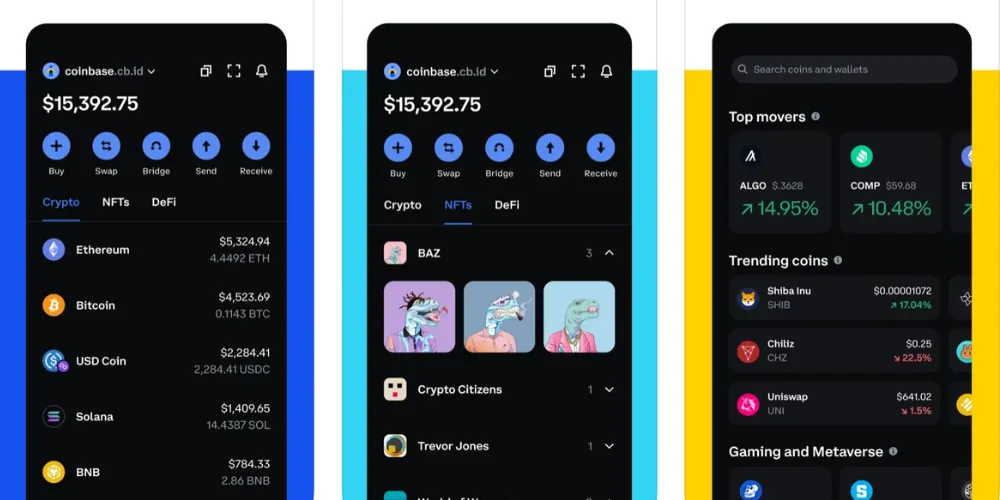
- Sync directly to Coinbase exchange
- Mobile app and browser extension
- Preconfigured blockchains
- Purchase with selected fiats in-wallet
- Coinbase company backing
- Fee for coin swaps in the wallet
- No DEX in the wallet, you must connect to an external exchange
Trezor Model T – Best wallet for experienced users
Trezor Model T Wallet
Finder score
Price (USD)
Assets
Wallet type
The Trezor Model T wins our best pick for experienced users thanks to several advanced features which come together to give you greater control over your funds.
- Multisig. Multisig wallets allow for multiple stakeholders to manage a single Bitcoin wallet. This is particularly useful for businesses and families.
- Taproot. Trezor Suite supports Bitcoin Taproot addresses which can reduce fees, improve privacy and enable smart contracts on Bitcoin.
- Shamir backup. Instead of using a single seed phrase, Shamir backup distributes it across multiple phrases which can then be stored in different locations. Think of it like multisig for a seed phrase.
- Timelock. Users can delay a transaction until a specified block height.
- Tor Switch. Anonymise your crypto transactions using the Tor network, which can be enabled via Trezor Suite.
Where the Model T falls short is the range of coins and tokens it supports. The Trezor Suite software only supports a small handful of popular blockchains, but through third-party software, the Model T supports over 1,000 coins and tokens.
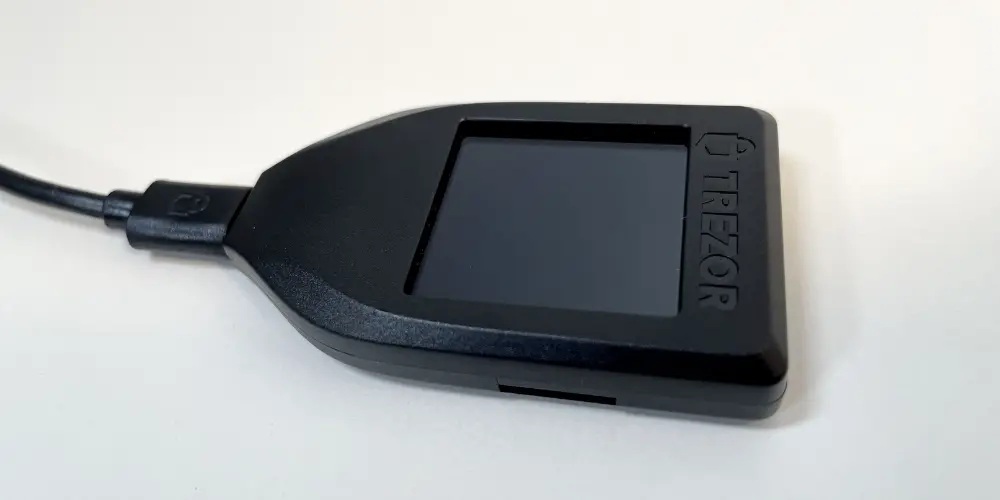
- Advanced transaction types for Bitcoin
- Highly customisable security features
- Integration with MetaMask for additional usability and DeFi
- Touchscreen for improved functionality and security
- In-app swaps and purchases
- Trezor Suite doesn't support every blockchain
- No native staking support in Trezor Suite, must use third-party apps
- Expensive compared to the Ledger Nano X
- No support for iOS
Zengo – Best for private transactions
Zengo wallet
Price (USD)
Assets
Wallet type
Zengo is a multi-chain wallet that supports Bitcoin, Ethereum, Polygon, Base and other blockchains across 380+ assets. It uses MPC (multi-party computation) instead of a seed phrase for security purposes, and it also offers 24/7 customer support.
Along with support for DeFi and NFTs, Zengo also lets you make private Bitcoin and Dogecoin transactions through its Pro service by generating new addresses every time you make a transaction.
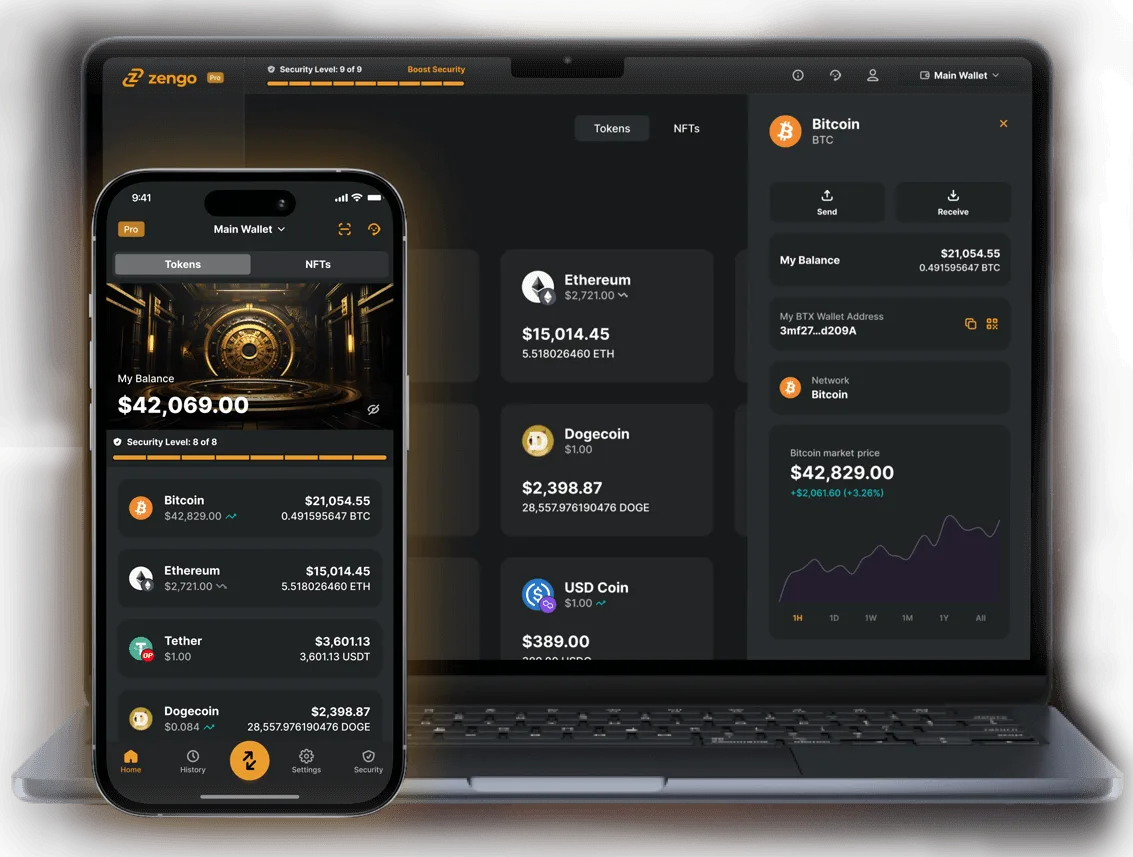
- Supports multiple networks
- Sophisticated security features
- Private transactions
- Pro service is relatively expensive
Ledger Stax – Best-designed crypto wallet
Ledger Stax Wallet
Finder score
Price (USD)
Assets
Wallet type
The Ledger Stax was designed by Tony Fadell, the co-creator of the iPod and iPhone, and is easily the most polished hardware wallet on the market.
The device is more sleek and stylish than previous Ledger hardware wallets, yet it still offers the same level of security for which Ledger wallets have come to be known and trusted.
The most notable feature of the Ledger Stax is its 3.7-inch (672x400px) electronic ink (e-ink) touchscreen, which makes managing your assets and clear-signing transactions via the device a smooth and convenient process.
Other features that make the Ledger Stax stand out from previous versions of Ledger wallets are its wireless-charging capability and its lock screen, which you can customise with an NFT.
The device is also shaped differently than previous Ledger wallets. It's the shape of about 5 credit cards stacked on top of one another, while all previous Ledger wallets resembled a flash drive.

- Large e-ink touchscreen
- Wireless Qi charging
- Bluetooth-enabled
- Enables clear-signing (to prevent hacks and phishing attacks)
- CC EAL 6+ security certification (highest level of security against penetration tests)
- Lock screen can be customised with NFTs
- Strong casing
- Sleek design
- Most expensive Ledger hardware wallet
- Can't stake many cryptos via Ledger Live
Phantom Wallet – Best wallet for Solana
Phantom Wallet
Price (USD)
Assets
Web browser
Wallet type
Phantom is a desktop and mobile software wallet that has established itself as the most popular choice for the Solana network, as well as NFTs.
It can be used on both iOS and Android devices, as well as browsers like Chrome, Firefox, Brave and Edge. While it is primarily a Solana wallet, it also supports Bitcoin, Ethereum and Polygon, and offers a convenient in-app swap feature that lets you move assets between networks in return for a flat 0.85% fee.
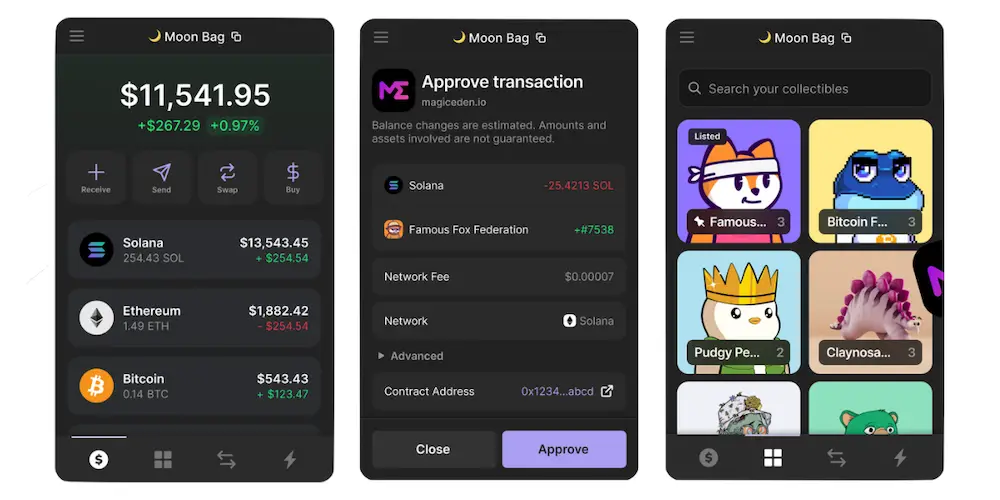
- Supports variety of browsers and devices
- Simple set-up and use
- Supports NFTs and multiple chains
- Doesn't offer Ledger support on Firefox
- Staking is only supported on Solana
MetaMask – Best software wallet overall
MetaMask Wallet
Price (USD)
Assets
Web browser
Wallet type
With over 30 million monthly active users at the time of writing, MetaMask is a crowd favourite and considered the go to for Web3 and Defi apps, making it an easy choice for best overall software wallet.
MetaMask was one of the first non-custodial wallets to help open the door to the world of Web3 and DeFi. Operating on both desktop and mobile devices, MetaMask lets you connect to dApps, store NFTs and digital assets and trade cryptos across several different blockchains.
A key feature behind the popularity of MetaMask's wallet is the ability to buy and sell cryptos without providing any personal information. To start trading on DeFi exchanges you simply install the app or browser extension and log in using your private seed phrase.
Your MetaMask seed phrase acts as a password, login and proof of ownership all in one. Your information is not stored on any database and asset ownership is entirely in your hands; an important element of decentralisation.
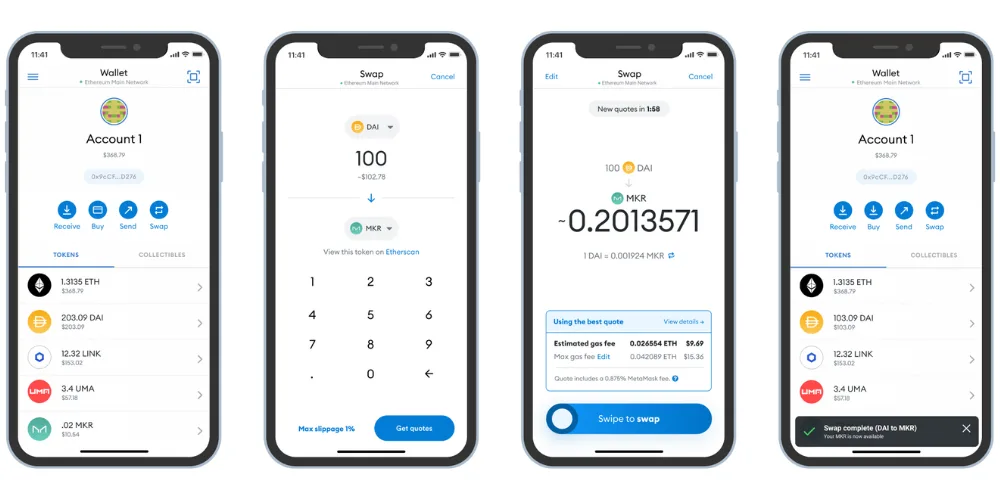
- Easy to set up and install
- No personal identification required
- Supports multiple blockchains, including testnets
- Portfolio dashboard makes managing assets easy
- Can set spending limits for added security
- Buy and sell tokens from within the wallet
- No native Bitcoin support
- Limited customer support
COLDCARD Mk4 – Best Bitcoin wallet
COLDCARD Mk4
Price (USD)
Assets
Wallet type
The COLDCARD Mk4 is a popular hardware wallet among hardcore Bitcoiners.
It was designed for Bitcoin maximalists by cypherpunks – technologists who advocate for privacy-enhancing technology.
The Mk4 doesn't have some of the functionality of Ledger or Trezor hardware wallets, but it does offer industry-leading security for the private keys to your BTC.
The device features 2 Secure Element chips – the same type of chips used to protect data for passports and credit cards – to protect your private keys.
To keep the private keys that you store on the device extra secure, you can send BTC to and from your device without even connecting it to a computer. When you use desktop software wallets like Sparrow or Electrum, you can use a microSD card to transfer data back and forth from your computer to your Mk4.
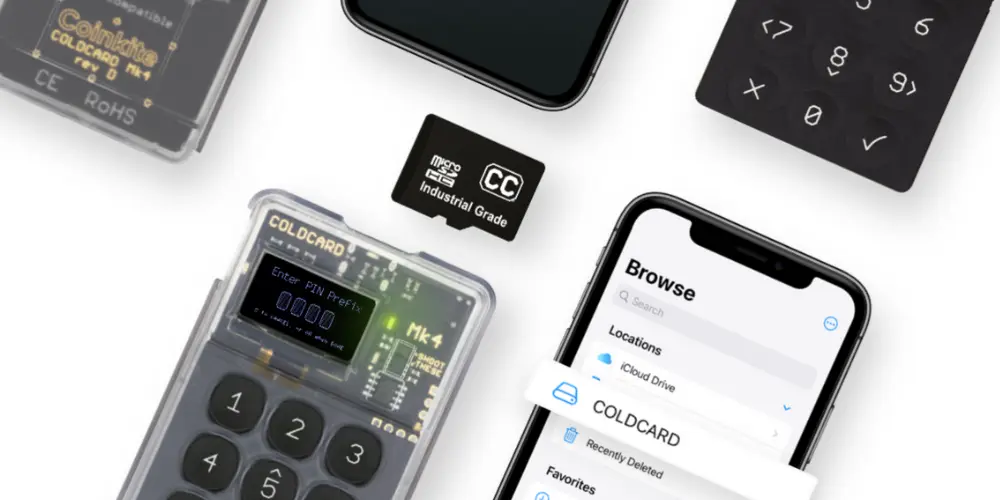
- Highly secure
- Contains 2 Secure Element chips
- Doesn't require a connection to computer
- Features a high-contrast 128 x 64 pixel screen for messaging
- Multisig-enabled
- Only supports BTC
- The user interface for Sparrow Wallet is less intuitive than competitor alternatives
- You will have to purchase a microSD card adapter for your computer if you prefer to transfer data via the card
Atomic Wallet – Most loved by customers
Atomic Wallet
Price (USD)
Assets
Desktop
Wallet type
Atomic Wallet supports Bitcoin, Ethereum and thousands of other coins and tokens along with staking on more than 20 coins. Atomic was also named the 'Most Loved' crypto wallet by customers in the Finder Crypto Wallets Customer Satisfaction Awards.

- Easy-to-use interface
- Lots of payment options
- Crypto trading feature isn't most competitive
Kraken Wallet – Best open source wallet
Kraken Wallet
Price (USD)
Assets
Wallet type
The Kraken Wallet is a self-custody wallet available for free for both iOS and Android. It enables you to mange crypto, NFTs and DeFi positions all on one platform. Plus, it uses biometric authentication and encryption technology to help ensure your funds are safe. The Kraken Wallet is open-sourced, which means you can count on transparency and community contribution.
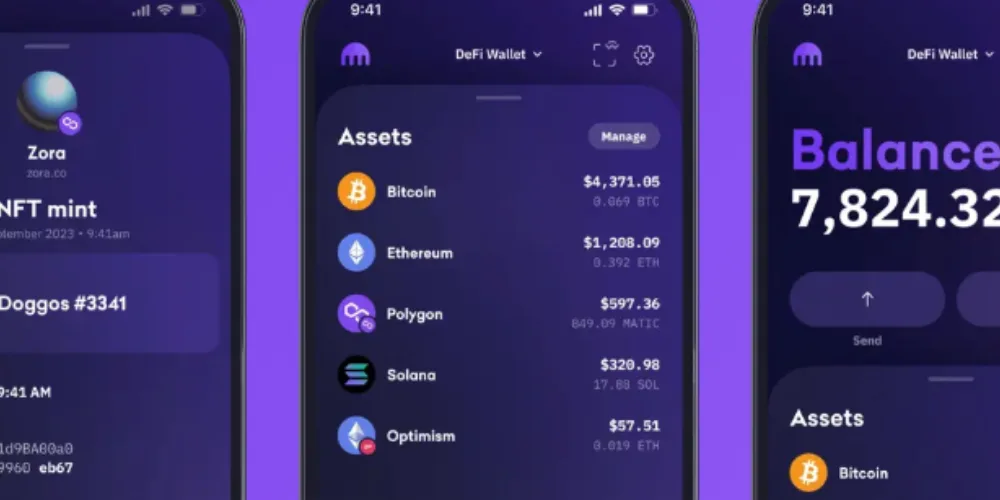
- Confirm transactions and send/receive on-chain with no tracking or data sharing
- Access to Bitcoin, Ethereum, Polygon, Dogecoin, Solana, Arbitrum, Base, Optimism and Blast networks
- Securely connect to the decentralized web
- Can purchase crypto with a credit card
- You can get access to a wider range of crypto assets with other wallets
- Less secure than a hardware wallet
eToro Wallet – Best for copy traders
eToro
Price (USD)
Assets
Wallet type
eToro’s wallet stands out as the best choice if you’re looking for a digital multi-asset solution.
Designed to offer more than just crypto storage, you can manage a wide range of assets on the eToro platform, including cryptos, stocks, commodities and more.
Although hardcore crypto enthusiasts may not love eToro’s diverse approach, the user-friendly interface and integration between the eToro crypto wallet and the rest of the eToro trading platform makes it easier for investors to manage a diversified portfolio all in the same place.
With a strong focus on regulation and security, eToro will appeal to UK crypto investors wanting a versatile, multi-asset wallet with an emphasis on simplicity and global compliance.
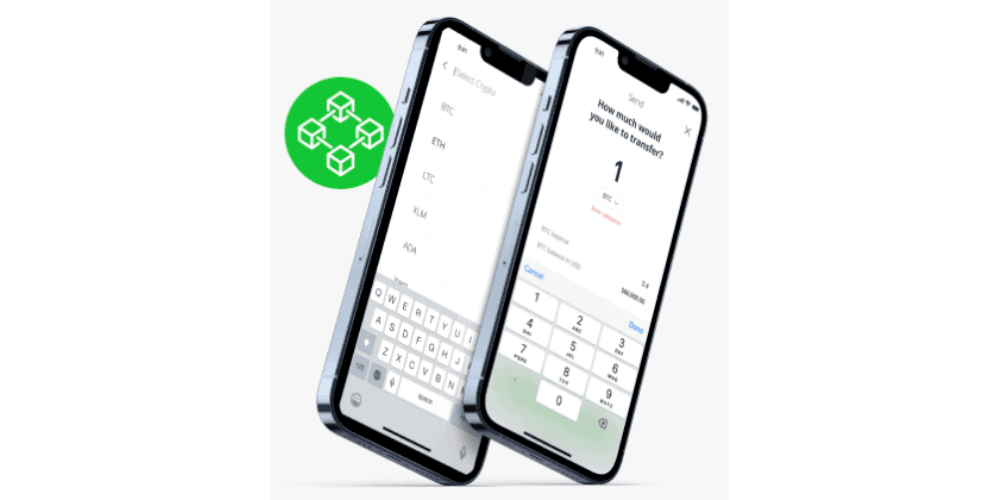
- User-friendly interface
- Supports over 30 cryptocurrencies
- Simple to use when trading via the eToro exchange
- To withdraw crypto, you first need to send it to an eToro Money crypto wallet before you can send it to another wallet
- eToro has fewer digital assets than dedicated cryptocurrency exchanges
- Centralised exchange wallets are less secure than hardware wallets
Top 5 cryptocurrency wallets for customer satisfaction
The Finder customer satisfacion awards ask Australians which brands and products they trust and love the most. For the crypto wallets customer satisfaction awards, we surveyed hundreds of Australians to rate their crypto wallet.
| Wallet | Overall satisfaction | Trustworthy/reliable |
|---|---|---|
★★★★★ 4.13/5 | 83% | |
★★★★★ 4.01/5 | 89% | |
★★★★★ 3.94/5 | 83% | |
★★★★★ 3.93/5 | 83% | |
★★★★★ 3.79/5 | 91% |
Best Bitcoin wallets Australia
With the notable exception of MetaMask, all of our best crypto wallet selections can also help you safely store your Bitcoin.
The following are some of our other picks for the best Bitcoin wallets in Australia.
| Wallet type | Asset support | |
|---|---|---|
Electrum Bitcoin Wallet | Hot | Bitcoin only |
Sparrow Bitcoin Wallet | Hot | Bitcoin only |
Wasabi Bitcoin Wallet | Hot | Bitcoin only |
Mycelium Bitcoin Wallet | Hot | Bitcoin only |
Blockstream Jade | Cold | Bitcoin only* Blockstream Jade technically supports a handful of other assets that exist on Liquid Network – a Bitcoin Layer 2 network. |
Ledger wallets (Ledger Stax, Ledger Flex, Ledger Nano X, Ledger Nano S Plus) | Cold | Multi-asset |
Trezor wallets (Trezor Safe 5, Trezor Safe 3, Trezor Model T, Trezor Model One) | Cold | Multi-asset |
SafePal S1 | Cold | Multi-asset |
What's the difference between a hot and cold wallet?
When deciding which Bitcoin wallet is best for you, you have to first decide whether you'd like to use a hot or cold wallet.
Hot wallets are crypto wallets that remain connected to the internet and are therefore less secure than cold wallets, which can store your assets offline and less suspectible to hacks.
However, hot wallets can be more accessible and easier to use. As a general rule of thumb, you should try and move your holdings to a cold wallet and only use a hot wallet when actively trading or transacting your crypto.
Hot wallets can be used in conjunction with a cold wallet like our pick for the Best Bitcoin wallet, the COLDCARD Mk4.
What is a crypto wallet?
A cryptocurrency wallet is a software program that allows you to store, send and receive digital currencies.
Because cryptocurrency doesn't exist in any physical form, your wallet doesn't actually hold any of your coins – instead, all transactions are recorded and stored on the blockchain.
Some cryptocurrencies have their own official wallets, while other products allow you to store multiple currencies within the same wallet.
Bear in mind that different digital currencies have different address types and you're usually only able to send coins between like wallet addresses. This means you'll need to send Bitcoin to a Bitcoin wallet address, Ethereum to an Ethereum wallet address and so on.
Finder survey: How many Australians use a crypto wallet?
Response | |
|---|---|
| No | 42.03% |
| Yes - Coinbase | 18.12% |
| Other | 14.13% |
| Yes - Ledger | 8.33% |
| Yes - MetaMask | 7.97% |
| Yes - Crypto.com | 7.25% |
| Yes - Trust Wallet | 4.35% |
| Yes - Exodus | 3.26% |
| Yes - Trezor | 3.26% |
| Yes - Coinomi | 0.72% |
How do cryptocurrency wallets work?
Instead of holding physical coins, a wallet has a public key and a private key.
- Public key. This is a long sequence of letters and numbers that forms the wallet address. With this, people can send money to the wallet. It's similar to a bank account number in that it can only be used to send money into an account.
- Private key. This is used to access the funds stored in the wallet. With this, people can control the funds tied to that wallet's address. It's a lot like your PIN number in that you should keep it 100% secret and secure. However, it's worth noting that not all wallets give you sole ownership of your private key, which essentially means that you don't have full control over your coins.
As well as storing your public and private keys, crypto wallets interface with the blockchains of various cryptos so that you can check your balance and send and receive funds.
How wallets and blockchains interact
The blockchain of any cryptocurrency contains a public record of all the transactions that have been made since it began. Your wallet address keeps a record of all your transactions and tracks your crypto balance. By following the chain all the way to the present day, a wallet can figure out how many coins you have.
For example, let's say Alice sends Bob 0.001 BTC. Once this transaction has been verified and added to the blockchain, the ledger records that the amount of Bitcoin at Alice's wallet address has decreased by 0.001 and that the amount of Bitcoin at Bob's wallet address has increased by 0.001 BTC.
The amounts sent and received as well as the public wallet addresses are all public information.
Types of cryptocurrency wallets
Let's take a closer look at the different types of wallets available. Each has its own advantages and disadvantages in terms of security, ease of use, convenience and a range of other factors.
Hardware wallets
- Generally considered to be the most secure option, offline storage, easy to set up and use.
- Most expensive option and inconvenient if you want quick access to your funds.
Hardware wallets are considered the most secure type of wallet.
They are special devices, similar to USB drives, that connect to your computer. They store your private keys which are used to manage your cryptocurrency (eg, make transactions).
Because the private keys are stored on this separate device, and not your computer or phone, they are technically stored offline and considered much more secure. This is called "cold storage".
The downside is that you need access to the physical device any time you want to make a transaction, which makes it best for long-term storage or use at home, but not ideal for anyone who wants access to their crypto 24/7 or while on the move.
They also cost you money, typically ranging from around $80 to more than $600. Despite the cost, the security and peace of mind they provide is worthwhile.
Popular hardware wallets include the Trezor and Ledger range of wallets.
Software wallets
- Easy to use, good level of security, plenty of choice, free to download.
- Risk of computer viruses and malware. Inconvenient if you want to manage your crypto on the go.
Software wallets are apps, browser extensions or websites that store your private keys and are used to manage your cryptocurrency.
They tend to focus on convenience and ease of use. Many now integrate with Web3 software, which means you can use your cryptocurrency with applications made for crypto like games, finance, art and collectibles, NFTs and more.
Software wallets are a good entry point for beginners who don't have enough funds yet to warrant buying a hardware wallet, or want to use Web3 apps regularly.
The downside though is that they're always connected to the internet, which means they are at greater risk of hacks, phishing attempts or malware. Any wallet connected to the internet is called a "hot wallet".
Software wallets can be installed across multiple devices, but you will need to set them up ahead of time. So you will need to access them from your personal phone, laptop or tablet which makes them less accessible than an exchange wallet, but more accessible than a hardware wallet.
Software wallets are typically free.
Exchange wallets
- Convenient if you plan on trading frequently. Easily access your funds with your account name and password from any device.
- You don't own the private keys, exchanges are targets for hacking and phishing scams.
Exchange wallets refer to keeping your cryptocurrency on the same platform or exchange you bought it on.
When you do this, the platform manages your private keys on your behalf, reducing the complexity involved with properly storing your private keys.
This means you can easily access your crypto with just your account name and password. If you used an exchange website to buy your crypto, then you can also access it anywhere you have access to the internet.
This makes it an extremely convenient way of storing crypto if you need regular access to it round the clock, which is why many traders typically keep their crypto on exchanges, despite the risks.
Leaving your crypto on an exchange is considered the most risky way to store it. This is because exchanges are frequently the targets of attempted hacks, theft and phishing scams.
If you plan to leave your crypto on an exchange, make sure to enable two-factor authentication and other enhanced security measures.
Exchanges are also at risk of mismanagement. Events like the collapse of the FTX Exchange show that exchange operators may engage in business practices that put user funds at risk.
How to choose the best crypto wallet
Now that you know all about the different types of wallets available, it's time to find a wallet that's right for you. To do that, you'll need to consider your needs and compare a range of wallets based on several key factors, including the following:
- The type of wallet you want. This factor comes down to personal preference. If security is your number 1 priority, you'll probably want to compare hardware wallets. But if your main goal is being able to quickly and conveniently access your coins, a mobile or web wallet may be your preferred choice.
- Ease of use. Sending, receiving and storing cryptocurrency can be complicated and confusing, particularly for beginners. It's essential that any wallet you choose suits your tech knowledge and level of crypto experience. So while crypto novices might focus on finding a wallet that is simple to set up and use, experienced holders might look for more advanced features including in-wallet exchange and multi-signature transactions.
- Security features. Find out the security features of the wallet such as 2-factor authentication and multi-signature functionality. Will your private key be stored online or offline? Has the wallet ever suffered any security breaches?
- Other features. Check what other features the wallet includes, such as the ability to exchange between currencies within your wallet or providing easy access to live fiat exchange rates or other market information.
- Supported cryptocurrencies. Are you looking for a wallet that stores just 1 crypto, like Bitcoin, or are you in the market for a multi-currency wallet? Make sure the wallet you choose is compatible with the cryptocurrencies you need to store and remember that some coins and tokens can only be held in an official wallet.
- The team behind the wallet. Next, see what sort of information you can find out about the people behind the wallet. How long have they been in business? What qualifications do they have? Are they continually working to upgrade and improve the wallet?
- Cost. While most crypto wallets are free to use, choosing a hardware wallet means you'll have to be willing to part with some cash. Consider the upfront price and shipping costs when making your decision. Some wallets charge a fee for every transaction you make, so check the fine print.
- Reputation. What level of community trust does the wallet have? Check out a range of independent online reviews to gauge how other users rate the wallet and whether they would recommend it.
Want to compare more options?
You can use the table below to compare a bigger range of the top crypto software and hardware wallets on price and supported assets.
Ask the experts: What are the most important features in a crypto wallet, besides security?

"A wallet should have an intuitive and easy-to-use interface, making it accessible to both beginners and experienced users. The ability to store and manage a variety of cryptocurrencies is crucial, as the crypto market consists of numerous digital assets. A good wallet should provide a reliable backup and recovery system to protect against data loss or theft of the wallet's private keys. Access to transaction history and reporting features is essential for tracking your cryptocurrency holdings and activities."

"Interoperability with web3-enabled sites is probably the most important feature after security for crypto wallets today. WalletConnect makes it possible to use a wide range of wallets to interact with web3 sites. Cross-chain compatibility and the ability to do swaps inside the wallet can also make life a lot easier."

"The wallet should be easy to use and navigate. Users should be able to easily send, receive, and store their cryptocurrencies. The wallet should support the cryptocurrencies that users want to use. Multi-signature wallets require multiple signatures to authorise transactions. This makes them more secure than single-signature wallets.Cold storage wallets allow users to store their cryptocurrencies offline. This is the most secure way to store cryptocurrencies, as it protects them from hackers. Some crypto wallets offer additional features, such as staking, lending, and decentralized exchange (DEX) integration."
Compare cryptocurrency wallets
How to use a crypto wallet
The first thing to understand is that how you use a cryptocurrency wallet will vary depending on the wallet you've chosen, and the blockchain (or coins) you're using.
While the basic principles are similar, you should make sure to read a guide specific to the wallet you've downloaded before making any transactions.
How to receive cryptocurrency to your wallet
The first thing you will need once you've got a new wallet is to deposit funds into it.
To receive crypto to your wallet, you need to find the address, which is also called the public key. The address is a long, alphanumeric string of numbers and letters.
Here is an example of a Bitcoin address: bc1qar0srrr7xfkvy5l643lydnw9re59gtzzwf5mdq
And an Ethereum address: 0xb794f5ea0ba39494ce839613fffba74279579268
Your public key is the address you will use to receive cryptocurrency transactions too. It will be displayed somewhere in your wallet.
It works a bit like an email address, meaning that you provide it any time you want to receive funds from yourself or someone else.
Let's take a look at how that works.
How to send cryptocurrency from one wallet to another
You can only send cryptocurrency to an address of the same type. That means you can only send Bitcoin (BTC) to a Bitcoin blockchain address, or Ethereum (ETH) and Ethereum tokens (ERC-20) to an Ethereum address. If you send coins to the wrong type of address, they will be lost forever and you will lose your money.
Once you have the address you want to send funds to, go to the wallet or exchange that you want to send funds from.
For example, if you're moving funds off an exchange like Binance or Coinbase, then you will want to go to the withdrawals tab of the exchange.
You will see a field asking you to put the address you want to send funds too, as well as much crypto to send.
This is where you enter the address you found earlier. The easiest way to do this is by using the copy paste command on your keyboard.
Even when using copy paste, always make sure to check the address was entered correctly.
How to keep your crypto wallet safe
Wallet security is a crucial consideration for any crypto owner, so keep these tips in mind to ensure you keep your funds as safe as possible:
- Research before you choose. Don't just choose the first crypto wallet you come across. Thoroughly research the security features and development team behind a range of wallets before making your final decision.
- Enable 2-factor authentication. This is a simple security feature available on an increasing number of wallets. It's simple to use and provides an extra layer of protection for your wallet.
- Pick your password carefully. Don't be lazy when choosing a password. Make sure all usernames, PINs and passwords related to your crypto wallet are as strong as possible.
- Consider a multi-signature wallet. Multi-signature wallets require more than 1 private key to authorise a transaction, which means another user or users will need to sign each transaction before it can be sent. Though this means it'll take a little longer to send funds, you may find that the extra peace of mind is well worth the minor hassle.
- Update your antivirus protection. Make sure your PC, laptop, smartphone or tablet has the latest antivirus and anti-malware software installed. Make sure to set up a secure firewall on your computer and that you never install software from companies you don't trust.
- Update your wallet software. Take care to update your wallet software regularly so that you always have the latest security upgrades and protections installed.
- Make a backup. Ensure that you have a wallet backup stored in a safe place so you can recover your crypto funds if something goes wrong, like if you lose your smartphone.
- Check the address. When sending or receiving funds, make sure you're using the correct wallet address. Similarly, if using an online wallet, make sure it is secure (i.e. check that its URL starts with "https://")
- Don't use public Wi-Fi. Never access your wallet over a public Wi-Fi network.
- Split your holdings. Consider splitting your crypto coins up between online and offline storage. You can keep a small portion of your funds in online storage for quick and convenient access, and store the bulk of your holdings offline for extra security.
- Private key protection. Remember – you can't access your coins without your private key, so don't disclose it to anyone. Check whether the wallet you choose allows you to retain full control of your private keys, or whether you'll have to surrender ownership to a third party such as an exchange.
Risks of using a crypto wallet
When you use a non-custodial crypto wallet, you reduce the risk of a third-party custodian like a crypto exchange going under and taking your funds with it. However, there are still risks to using both software and hardware crypto wallets.
Software wallets are always connected to the internet, and, for that reason, can more easily be hacked. Also, if the code for a software wallet is closed-source, you are placing trust in the creator of that wallet to not extract your private keys and, therefore, gain access to the digital assets you manage via the wallet.
Hardware wallets are generally more secure than software wallets in that they remain disconnected from the internet when they aren’t in use, while some never have to be connected to the internet. However, if you use a hardware wallet that has native software — like a Ledger or Trezor wallet — there is always the risk that your private keys can be extracted through an issue with the underlying software.
For extra safety, it’s best to create a multisignature — or “multisig” — set up in which you use two or more wallets to sign transactions and protect your crypto.
Bottom line
There's no such thing as a one size fits all "best crypto wallet." The right wallet for you will match your needs, so if security is your number 1 concern, you'll probably end up choosing a different wallet to someone who wants fast and easy access to their coins.
The key thing to remember is to do your research and compare a range of wallets first. Start with our range of crypto wallet reviews to get an idea of what's available and the key features you need to consider.
Methodology
To evaluate our 2025 picks for the best crypto wallets, we compared 50+ wallets on a range of criteria, including the following:
- Crypto and blockchain compatibility. Does it support a good breadth of coins, tokens and blockchains?
- Ease of use. Is it user-friendly and suitable for new crypto investors?
- Security. Does it offer non-custodial or offline cold storage for added security?
- Cost. Is it a free software wallet or is there an initial outlay? If applicable, how does its price compare to similar products?
- Extra features. Does it support NFTs or offer additional features such as staking or in-wallet purchases?
- Mobile accessibility. Can you manage your portfolio from a mobile device?
- Web3 support. Can you directly access Web3 and decentralised apps (dapps) from within the wallet?
Crypto wallets market update: July 2025
A wallet holding around $1 billion of Bitcoin that has been dormant since 2011 has recently activated. In early July 10,000 BTC were transferred from this wallet to a new wallet, according to a post from Whale Alert on X.
Frequently asked questions about crypto wallets
Read our crypto wallet reviews
Disclaimer: Cryptocurrencies are speculative, complex and involve significant risks – they are highly volatile and sensitive to secondary activity. Performance is unpredictable and past performance is no guarantee of future performance. Consider your own circumstances, and obtain your own advice, before relying on this information. You should also verify the nature of any product or service (including its legal status and relevant regulatory requirements) and consult the relevant Regulators' websites before making any decision. Finder, or the author, may have holdings in the cryptocurrencies discussed.
Ask a question
14 Responses
Read more on Wallets
-
Best wallet review
Best Wallet is a mobile crypto wallet that makes it easy to purchase and store crypto.
-
NGRAVE ZERO review
Learn about the capabilities, benefits and pitfalls of the NGRAVE ZERO hardware wallet.
-
SafePal S1 review
The SafePal S1 hardware wallet provides added security for the feature-rich SafePal software wallet.
-
Ledger Stax review
Learn how the Ledger Stax stands out compared to previous Ledger hardware wallets.
-
11 best non-custodial wallets (2025)
Our round-up of the best non-custodial crypto wallets and why they're so important.
-
Ledger Nano S Plus review
Learn about the capabilities, benefits and pitfalls of the Ledger Nano S Plus hardware wallet.
-
Ledger Nano X review
See how the Ledger Nano X hardware wallet stacks up when it comes to security, features and price tag.
-
The 8 best hardware wallets in Australia
Compare the security, features and capabilities of some of the best crypto hardware wallets on the market.
-
Trezor Model T review
See how the Trezor Model T measures up as a crypto hardware wallet.
-
Trezor One review
See how the Trezor One compares in the world of crypto hardware wallets.



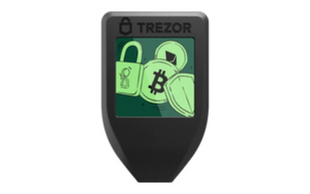


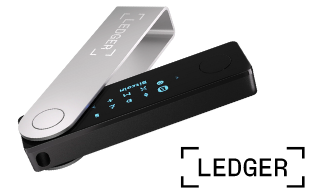
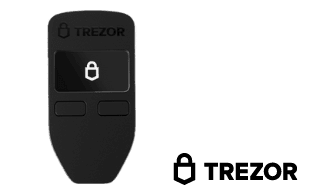






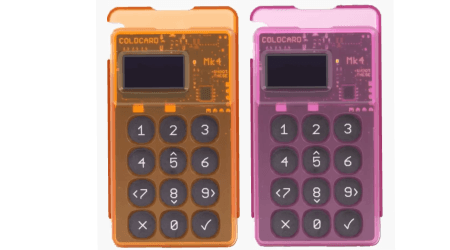











Hello, Atomic wallet was hacked on the 3rd of June 2023 draining 100 million worth of crypto from users. To date Atomic wallet have acted poorly towards victims and still leaves its exploited software up for downloads. This is a dishonest company. I urge you to do a search about the hack on the 3rd and you will see for yourself. This wallet needs to be removed from your recommendations else you will be exposing new unsuspecting users to be put in danger.
Thank you for your comment John.
We’ve reviewed the situation surrounding Atomic Wallet and chosen to removed them from our website until we understand more about the security breach.
Thank you for reaching out – your comment was very helpful.
How do I sign up?
Hi Len,
Thanks for getting in touch with Finder. I hope all is well with you. 😃
If you want to sign up and create a cryptocurrency wallet, you can click on the “Go to site” green button of your desired provider. You can also use our table to compare your options first based on wallet type and support cryptocurrencies.
I hope this helps. Should you have further questions, please don’t hesitate to reach us out again.
Have a wonderful day!
Cheers,
Joshua
I have the option to have my funds sent BTN orBCH I have both wallets does it make any difference?
Hi there,
Thanks for leaving a question on finder.
Unfortunately, we can not recommend a wallet since we are a comparison website and we do not represent any of the providers on our page. You will have to do the comparison on your own in this page.
Cheers,
Joel
Hi Tochi,
Thanks for your question. At the moment, we do not have a review for mycryptowallet.com though I can forward this to our team so they can check and for consideration.
Cheers,
May
How do I sell my cripto coins from Coinbase
Hi Ross,
Thanks for reaching out.
For Coinbase, the sell option is currently not available in Australia. In the meantime, you may refer to our guide on how to sell bitcoin with other cryptocurrency exchange that is supported in the country. You can use our comparison table to help you find the platform that suits you. When you are ready, you may then click on the “Go to site” button and you will be redirected to their website where you can sign up or get in touch with their representatives for further inquiries you may have.
As a friendly reminder, cryptocurrencies are speculative, complex, and involve significant risks – they are highly volatile and sensitive to secondary activity. Performance is unpredictable and past performance is no guarantee of future performance. Consider your own circumstances, and obtain your own advice, before you make any decisions.
Cheers,
Joanne